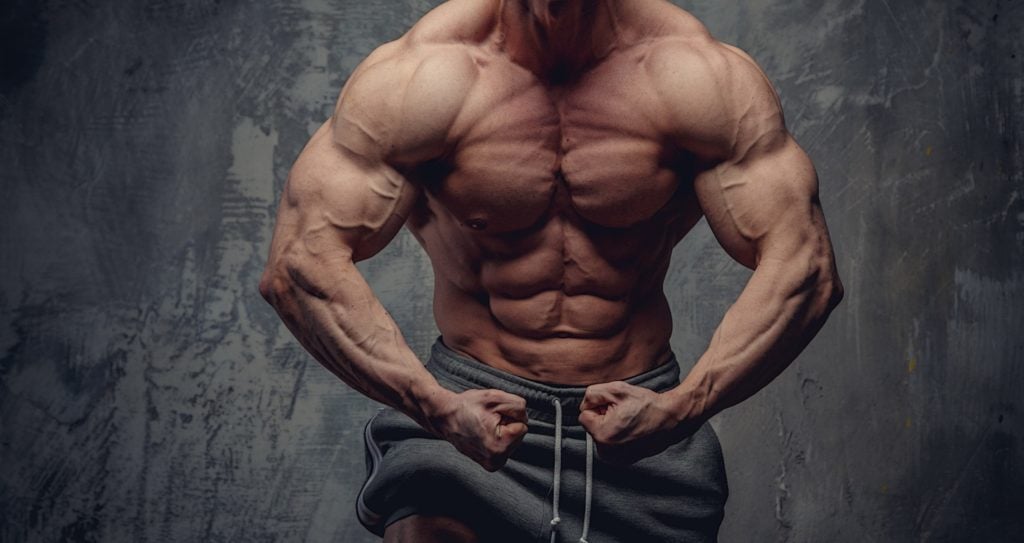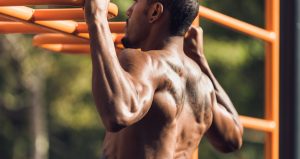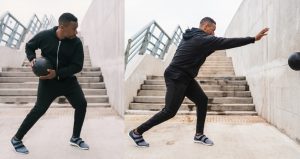Eight Moves to Do to Increase Power Output for Sports
There’s a popular misconception that speed, leaping ability, and power are gifts, not traits that can be improved in the gym like strength.
Some athletes indeed have a more natural ability in these areas, but power, in particular, is one that can be improved upon. Several studies have shown that athletes can jump higher, accelerate faster, and change direction more rapidly through training. These powerful movements translate throughout sports, whether it’s a golfer or baseball player driving a ball, a basketball or volleyball player leaping, or a swimmer bursting off the wall at the end of a flip turn.
Here are eight moves to boost power output for sports.
 Goblet Squats
Goblet Squats
What it does: This develops power in the lower body by challenging the glutes, quads, calves, and your overall core.
How to do it: Hold a kettlebell with two hands against your chest as if preparing to drink from it, goblet-style. Squat by sitting the hips back and down, keeping the weight in the heels of the feet without lifting the toes. Maintain contact between the kettlebell and the chest. The elbows should touch the knees lightly. Rise and extend powerfully through the hips.
How many? 2 sets of 10 reps with 30 seconds rest between sets.
Alternating Dumbbell Press
What it does: This promotes shoulder stability and power without placing undue pressure on the joint, as a barbell press might. So many sports lend themselves to shoulder injuries – baseball, swimming, tennis, among others – and this is a better alternative.
How to do it: Lie face-up on a bench, holding dumbbells at the outside of the shoulders and with palms facing the thighs. Lift both dumbbells over the chest. Keep one dumbbell raised above the chest as you lower the other dumbbell, touching it to the outside of the shoulder, and pushing it back up. At the top of the movement, push farther with both hands, as if trying to punch the ceiling. Switch sides.
How many? 2 sets of 10 reps on each side with 30 seconds rest between sets.
 Pullups
Pullups
What it does: A pullup, done properly, generates full extension through the lats, back, shoulders, and wrist. That extension is key to producing power in almost every sport.
How to do it: Hanging from a bar with either an overhand or reverse (underhand) grip, pull the shoulder blades back and down to lift the body. Finish by pulling with your arms. The key is to return to the fully extended position after each rep. Otherwise, you’re not reaching full extension, the movement you want in sports.
How many? 2 sets of 10 reps on each side with 30 seconds rest between sets.
Romanian Deadlift (RDL)
What it does: Jumping higher and being more explosive comes from the ability to hinge from the hips, rather than jumping from the knees, which leads to injuries. RDLs also build strength in the hamstrings, glutes, and back.
How to do it: Stand with feet shoulder-width apart, holding a dumbbell at each side. The weight should be on the back half of your feet. Shift the hips back and lower the dumbbells as far as possible while keeping the back straight. Fire the hamstrings and glutes as you return to standing position.
How many? 2 sets of 10 reps on each side with 30 seconds rest between sets.
Physioball Leg Curl
What it does: This keeps the hips extended and forces the hamstrings to work, ultimately improving leaping ability and posterior strength.
How to do it: Lie on the ground, face up, with legs straight and heels on a physioball. Brace the shoulders and relax the neck. Squeeze the glutes to raise the hips, and pull the ball toward you. Don’t drop the hips as the ball comes toward you. Extend the legs again, then repeat the leg curl for 10 reps. Make sure your hips never touch the ground.
How many? 2 sets of 10 reps on each side with 30 seconds rest between sets.
Squat Jump
What it does: This works the hips, knees, and ankles. The so-called “triple flexion response” creates power and helps limit injuries.
How to do it: Stand with feet just outside the shoulders and hangs behind your head. Squat, keeping knees behind the toes. After holding this position for two seconds, jump vertically. Pull the toes toward the shins in midair to prepare for landing. Land in the starting squat position, hold 3 seconds, and repeat for 10 reps. Be sure to land softly—like a cat—with the hips back and down.
How many? 2 sets of 10 reps on each side with 30 seconds rest between sets.
Medicine Ball Rotational Throw
What it does: This improves an athlete’s ability to store and release energy from the hips.
How to do it: Stand facing a concrete block wall about 3 feet away. Hold a medicine ball at waist level. Rotate your trunk away from the wall as you wind up. Initiate the throw by thrusting your hip toward the wall, followed by the trunk, arms, and the ball. Throw the ball off the wall, then catch it with your arms slightly bent, one hand under the ball, the other behind it. Repeat for 10 reps, then switch sides.
How many? 2 sets of 10 reps on each side with 30 seconds rest between sets.
Lateral Bound
What it does: This builds explosive lateral power in your legs, which helps athletes with fast cuts and side-to-side movements.
How to do it: Stand balanced on your right leg, with your left foot on the ground. Squat slightly with the right leg, then use the leg and glutes to jump to the left. Extend your ankle, knee, and hip, and land on the left leg only, making sure to maintain your balance. Hold for a count of three, then bound to your right. Do 10 reps per side.
How many? 2 sets of 10 reps on each side with 30 seconds rest between sets.
Pete Williams is a NASM-CPT and the author or co-author of several fitness books, including Core Performance and Every Day is Game Day. His work has appeared in publications such as Men’s Health, Men’s Journal, and USA Today.

 Goblet Squats
Goblet Squats Pullups
Pullups







